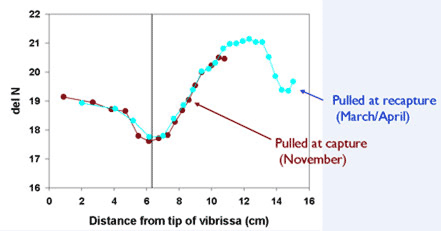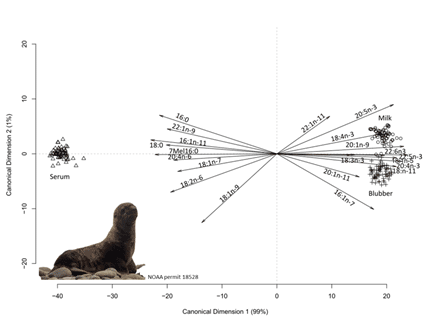Steller Sea Lion Research
Understanding diet and foraging using chemical signatures
Understanding what Steller sea lions eat and how and where they forage is important in determining whether changes in prey availability were a contributing factor in their decline and/or currently impeding recovery of the western population. Most traditional methods used to investigate diet, such as examining stomach contents, collecting and analyzing scat (feces), and direct observations, have biases such as the short timeframe of sea lion diet representation and under-representation of prey that have few hard parts (such as undigested fish bones or squid beaks). Additionally, to describe changes in diet over time would require laborious, repeated sampling at haulouts and rookeries which are limited by the seasonal presence of animals and accessibility. Increasingly, indirect methods using chemical tracers, including stable isotope analysis and fatty acid signature analysis, are being used to investigate the diet and foraging ecology of marine predators.
Stable Isotope Analysis
Stable Isotope (SI) analysis has proven to be an effective method to gather information of marine food webs. Measuring naturally occurring carbon (13C/12C, denoted as δ13C values) and nitrogen (15N/14N, denoted as δ15N values) in tissues provides information about the trophic position (roughly analogous to an animal's position on the "food web") and feeding habits of animals. Within a food web, as the trophic level of prey increases, δ15N values in predator tissues increase, while δ13C values remain relatively unchanged or increase very little. Further, in the marine environment, the characteristics of the habitat influence the SI signatures of the prey, and in general, δ13C values are more depleted (lower) in freshwater prey than strictly marine prey. Therefore, within a food web, δ13C values of predator tissues are used to estimate their foraging area (inshore vs. offshore food webs) and δ15N values are used to estimate trophic level of prey they consumed. We also use stable nitrogen to determine when young sea lions shift from a diet of mother's milk to independently hunting for prey. This method uses the logic that suckling pups are at a higher trophic level than the mothers they are consuming milk from, and that we should expect nitrogen values to drop, indicating a drop in trophic level, post-weaning. We have examined stable nitrogen found in milk, blood and whiskers (vibrissae), and have been able to identify a shift in the stable isotopes signatures associated with the shift from a milk diet to a fish diet. Whiskers are particularly useful because they provide an isotope record from before the animal was born (in utero deposition is at the tip of the whisker) to the time when the whisker is collected (between 1 and 48 months of age). Thus the shift in diet appears along the length of the whisker and is represented by the shift in isotope signature. We have published a study on the age specific rates of whisker growth in order to better determining ecological important events such as age of weaning (Rea et al., 2015).

To date the resulting stable isotope dataset has provided insight into the diet of gestating Steller sea lions (Scherer et al., 2015), estimation of trophic enrichment factors for diet modeling using stable isotopes (Stricker et al., 2015), and age-specific growth rates in Steller sea lion whiskers (Rea et al., 2015). While SI analysis in Steller sea lion whiskers has provided valuable information, it cannot indicate what types of prey the sea lions are eating. To this end, we have compiled a database of carbon/nitrogen signatures reported in the literature from known Steller sea lion prey in Alaska. We are investigating whether comparing the sea lion signatures to the prey signatures may indicate which prey items are present in an individual sea lion's diet.
Fatty Acids Analysis

Fatty acids from blubber have been widely used to assess the diets of marine mammals. Fatty acid data can be employed qualitatively and quantitatively. Qualitative analysis can provide information about spatial and temporal dietary and foraging patterns of marine mammals and to also make comparisons between sex and age classes. Thus far, qualitative analysis of Steller sea lion fatty acids from blubber has been used to describe differences in diet among location, year, season, and age, without identifying specific taxa consumed (Beck et al., 2007). Collecting sufficient blubber for analyses and tissue archive can be difficult particularly in young animals with small or developing blubber layers. Alternative matrices such as serum and milk would be useful.
Blubber, milk, and serum samples were collected from young free-ranging Steller sea lions. These samples have been analyzed for a suite of fatty acids (or "fatty acid signature"). While statistically different, blubber and milk samples were fairly similar suggesting that milk may be useful as an alternative tissue to track fatty acids in Steller sea lions. The use of milk samples provides information on the diet of pups (milk) but may also provide information on the diet of adult female Steller sea lions. For example, milk samples from the Aleutian Islands had proportionally more n-7 isomers whereas samples from Southeast Alaska which had fatty acids more prominent in pelagic teleost fish (more 22:1n-11 and 20:1n-9). These findings suggest that adult female Steller sea lions within the Aleutian Islands are more dependent on benthic prey (found on, in, or near the seabed) than females in Southeast Alaska.
